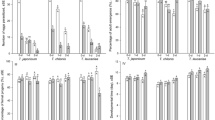Abstract
Studies were conducted to compare adult longevity, number of host eggs parasitized and temporal pattern of oviposition of four species of Trichogramma, T. brasiliensis Ashmead, T. chilonis Ishii, T. minutum Riley and T. japonicum Ashmead. Parasitoids were reared on eggs of Corcyra cephalonica St. at 27 ± 2°C and 60 ± 5 % r.h. With the exception of T. chilonis, females lived longer than males. The only thelytokous species, T. brasiliensis had the highest longevity and fecundity. However, T. chilonis was observed to lay more than 50% of its eggs on its first day of emergence. Of the four species, T. japonicum exhibited the shortest longevity and lowest fecundity.
Résumé
Des études ont été menées pour comparer la longevité de l’adulte, le nombre d’oeufs parasité et le type d’oviposition chez quatre espèces de Trichogramma, à savoir T. brasiliensis Ashmead, T. chilonis Ishii, T. minutum Riley et T. japonicum Ashmead, T. chilonis Ishii, T. minutum Riley et T. japonicum Ashmead. Les parasitoïdes furent élévés sur des oeufs de Corcyra cephalonica St. à 27 ± 2°C et 65 ± 5% r.h. A l’exception de T. chilonis, les femelles vivaient plus longtemps que les males. T. brasiliensis, la seule espèce à caractére thelytoque avait la plus forte fécondité et longevité. Toutefois, T. chelonis pondait plus de 50% de ses oeufs au cours du premier jour aprés émergence. De toutes les quatre espèces, T. japonicum a montré la plus courte longevité et la plus faible fécondité.
Similar content being viewed by others
References
De Bach P. and Hagen K. S. (1964) Manipulations of entomophagous species. In Biological Control of Insect Pests and Weeds (Edited by De Bach P.), pp. 429–458. Chapman Hall, London.
Duncan D. B. (1951) A significance test for difference between ranked treatments in an analysis of variance. Va. J. Sci. 2, 171–189.
Gomez K. A. and Gomez A. A. (1984) Statistical Procedure for Agricultural Research. John Wiley and Sons, New York.
Gonzalez D. (1988) Biotypes in biological control examples with populations of Aphidius ervi, Trichogramma pretiosum and Anagrus epos (Parasitic Hymenoptera).InAdvances in Parasitic Hymenoptera Research. Proc. II Conference on the Taxonomy and Biology of Parasitic Hymenoptera, University of Florida, Gainesville, Florida, 19–21 November 1987. pp. 475–482.
Nagarkatti S. and Nagaraja H. (1968) Biosystemic studies on Trichogramma species: I. Experimental hybridization between T. australicum Girault, T. evanescens Westwood and T. minutum Riley. Tech. Bull. Commonwealth Inst. Biol. Control 10, 8196.
Nagarkatti S. and Rao V.P. (1970) Possibilities of using egg parasites for biological control of sugarcane borers in India. Proc. Second Ann. Conf. South Indian Sugar and Sugarcane Tech., Bangalore pp. 101–104.
Raj D. (1975) Studies on the optimum potential and mass rearing of Trichogramma brasiliensis Ashmead. M.Sc. Thesis, Indian Agricultural Research Institute, New Delhi, India.
Sasaba T. (1966) Interspecific competition between two species of Trichogrammatidae III. The analytical study on the competition. Res. Popul. Ecol. Kyoto Univ. 8, 102–106.
Stinner R. E., Ridgeway R. L. and Marrison R. K. (1974) Longevity, fecundity and searching ability of Trichogramma pretiosum reared by three methods. Environ. Entomol. 3, 558–560.
Tuhan N. C. and Pawar A. D. (1983) Life history, host suitability and effectiveness of Trichogramma chilonis for controlling cane borers in Punjab (India). J. Adv. Zool. 4, 71–76.
van Lenteren J. C. (1983) The potential of entomophagous parasites for pest control. Agric. Ecosystems Environ. 10, 143–158.
Author information
Authors and Affiliations
Rights and permissions
About this article
Cite this article
Manickavasagam, S., Paul, A.V.N. & Farooqi, S.I. Biological Attributes of Four Species of Trichogramma (Hym: Trichogrammatidae)—A Comparative Study. Int J Trop Insect Sci 15, 173–176 (1994). https://doi.org/10.1017/S1742758400015411
Received:
Accepted:
Published:
Issue Date:
DOI: https://doi.org/10.1017/S1742758400015411
Key Words
- Biological attributes
- Trichogramma
- egg parasitoids
- longevity
- ovipositional pattern
- T. chilonis
- T. minutum
- T. japonicum
- Corcyra cephalonica



